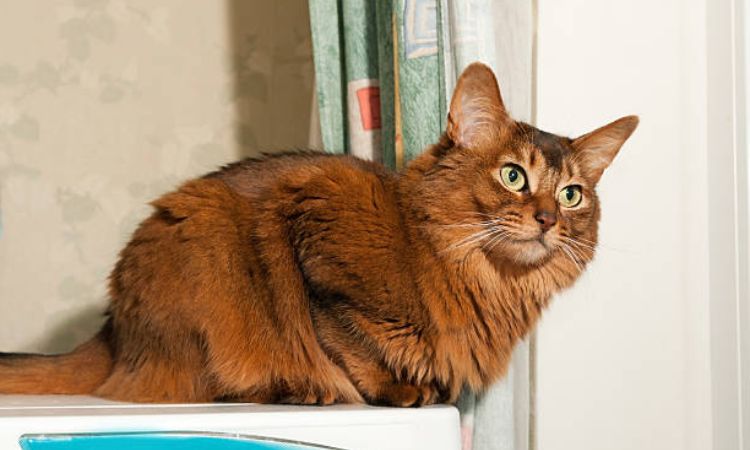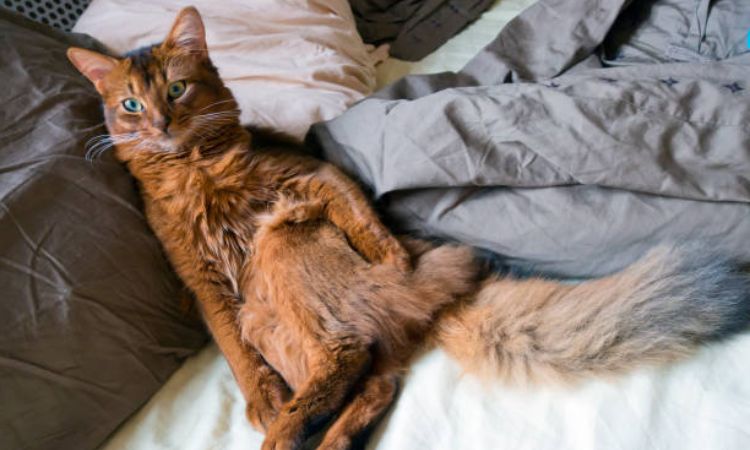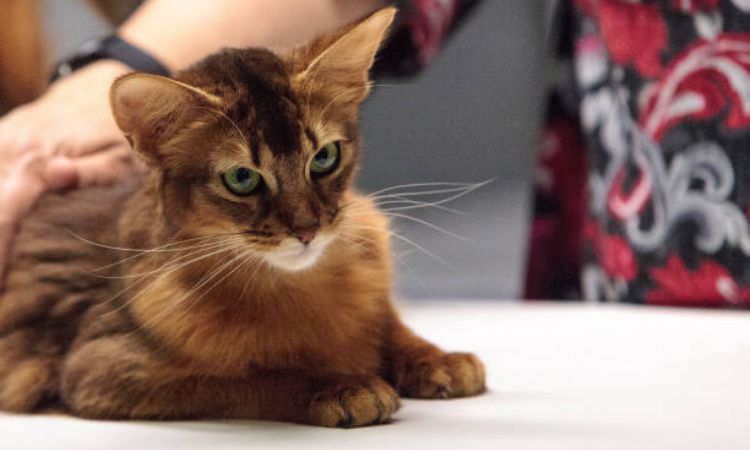If you’re looking for a cat that’s equal parts elegance and mischief, the Somali might just steal your heart. With its flowing, fox-like coat, agile frame, and sparkling curiosity, this medium-sized breed moves through life like a miniature jungle explorer.
Brimming with intelligence and energy, Somalis aren’t content to simply lounge they want to play, investigate, and be part of every adventure. Let’s dive into what makes the Somali cat so captivating: from its striking appearance and lively personality to the truth behind those “hypoallergenic” claims.

Introduction to the Energetic “Fox Cat”
The Somali cat is a stunning and energetic breed known for its long, luxurious coat and playful personality. It is essentially the long-haired cousin of the Abyssinian cat, distinguished by its soft, ticked fur that shimmers in the light. This beautiful breed is often referred to as the “Fox Cat” due to its striking resemblance to a fox, with a bushy, plumed tail, large upright ears, and an overall wild, elegant appearance.
Somali cats possess an athletic and graceful physique, making them not only visually appealing but also highly active and curious. These cats are full of energy, and their playful, mischievous nature adds to their charm. Unlike other breeds, they enjoy interactive play, climbing, and even the occasional “mischief,” like knocking things off shelves, which highlights their intelligence and curiosity.
The Somali cat’s origins can be traced back to the Abyssinian breed. A recessive gene for long hair within the Abyssinian gene pool led to the development of this new breed. In the 1940s, Abyssinian cats that carried this long-haired gene were exported to North America, Australia, and New Zealand. In 1953, the first long-haired Abyssinian, named Raby Chuffa of Selene, appeared in North America, and breeders began to take note of this unexpected variation.
In the 1960s and early 1970s, breeders such as Evelyn Mague in the U.S. and Don Richings in Canada began actively developing these long-haired Abyssinians, eventually naming them “Somali.” The breed was initially met with resistance from some Abyssinian breeders, who were reluctant to embrace this new variant, but over time, the Somali cat gained recognition for its unique charm and beauty.
The breed was officially recognized as a distinct breed in 1979 by the Cat Fanciers’ Association (CFA) in North America, and by the early 1980s, it was also accepted in Europe. The name “Somali” was chosen to reference the African nation of Somalia, which borders Abyssinia (modern-day Ethiopia), further linking the breed’s genetic and geographical ties. Today, the Somali cat is beloved for its friendly, active nature, and remains a popular choice for families and cat enthusiasts worldwide.
Physical Characteristics and Appearance
Size and Build
The Somali is a medium-sized, athletic cat with a lean, muscular, and graceful build. They are long-bodied, lithe, and agile, reflecting their active, playful nature.
- Weight: Typically 2.5–4.5 kg (5–10 lbs)
- Body Type: Muscular yet slender, built for jumping, climbing, and high activity
- Paws: Neat, oval-shaped, sometimes with tufts of fur between the toes, aiding in agility
The Distinctive Coat
The Somali is a semi-long-haired breed, known for its soft, silky coat that is longer around the neck, legs, and tail. Their fur exhibits an agouti (ticked) pattern, where each individual hair has multiple bands of color. This ticking effect gives the coat a shimmering, sunlit, and shaded appearance that is paler on the underside and darker on top.
- Coat Length: Medium-long; lies close to the body but fluffs at the ruff, legs, and tail
- Texture: Soft, fine, and silky
- Ticked Agouti Pattern: Creates a rich, multi-dimensional look
- Coat Colors: Ruddy (reddish-brown), Sorrel/Red, Blue, Fawn, with silver variations where the undercoat is white instead of cream
Head and Features
The Somali has a modified wedge-shaped head with gentle, soft contours that balance its lithe body. Its features are expressive and fox-like, contributing to the breed’s wild yet elegant appearance.
- Eyes: Large, almond-shaped, striking; typically green or gold with dark “eyeliner” pigment that enhances their intense expression
- Ears: Large, pointed, upright, alert, and highly expressive
- Tail: Long, full, and heavily plumed; one of the most defining characteristics of the breed, adding to its fox-like appearance
- Other Features: Tufts between the toes, strong whisker pads, and a softly curved nose bridge

Somali Cat Personality and Temperament
Somali cats are full of life, curiosity, and intelligence. Often described as the “furry toddler” of the cat world, they bring a playful energy to any household. Unlike more laid-back breeds, Somalis are always on the move—climbing, jumping, exploring, and finding inventive ways to entertain themselves. Their high energy and adventurous spirit mean they thrive in homes where they receive ample attention, mental stimulation, and interactive play.
Key Personality Traits
- Playful and Energetic: Somalis love games, climbing, and exploring. They enjoy interactive toys, fetch, and even puzzle feeders. Without adequate stimulation, they may create their own mischief—tipping objects, opening cabinets, or sneaking into places they shouldn’t.
- Intelligent and Curious: These cats are quick learners and can often be trained to perform tricks or respond to commands like “sit” or “stay.” Their intelligence also means they can get bored easily, so mental enrichment is essential.
- Affectionate but Independent: Somalis form strong bonds with their humans, often following them from room to room, but they are not typically lap cats. They prefer to show affection on their own terms—through playful interaction, head bumps, or snuggling nearby rather than being held.
- Social and Friendly: This breed tends to get along well with other cats and pets, especially if they have a companion to keep them company while their humans are away. They generally do well with children who understand how to interact gently and respectfully with animals.
- Vocal and Expressive: While not as talkative as Siamese cats, Somalis do communicate with soft chirps, trills, and meows when they want attention or want to share in the fun.
Lifestyle Considerations
Somalis are best suited to homes where they can receive plenty of interaction and stimulation. They enjoy climbing structures, high perches, and outdoor access in safe, enclosed areas. While they are independent enough to be left alone for short periods, they thrive in households where they are part of the daily routine and have engaging companions—human or otherwise.
Care and Health Considerations for the Somali
Grooming Needs
Despite their luxurious medium-long coat, Somalis are relatively low-maintenance compared to other long-haired breeds:
- Brushing: Weekly brushing is sufficient to keep their coat free from tangles and matting. During heavy shedding periods, additional sessions may be necessary.
- Dental Care: Regular brushing with cat-safe toothpaste and routine veterinary dental checkups prevent periodontal disease, a common issue in this breed.
- Nail Maintenance: Trim nails every few weeks to prevent overgrowth.
- Ear and Eye Care: Inspect ears for redness, odor, or debris and monitor eyes for irritation or discharge. Clean ears gently as needed—never use cotton swabs in the ear canal.
Exercise and Enrichment
Somalis are energetic, inquisitive, and highly intelligent, making physical and mental stimulation crucial:
- Daily Play: Interactive toys, puzzle feeders, fetch, and climbing activities keep them engaged.
- Vertical Spaces: Cat trees, shelves, and window perches allow climbing and observation, fulfilling their natural curiosity.
- Companionship: These social cats do best with regular human interaction or the company of another Somali or compatible pet to prevent boredom and separation anxiety.
Diet and Nutrition
Somalis are active cats with high energy requirements:
- High-Protein Diet: Focus on foods with quality animal-based protein to support muscle maintenance and overall health.
- Life Stage Nutrition: Provide kitten, adult, or senior formulations as appropriate.
- Measured Feeding: Feed at set times, usually twice daily, and monitor portions to prevent overeating. Consider slow-feeder bowls if necessary.
- Veterinary Guidance: Consult your veterinarian for advice on supplements or special dietary needs based on health conditions or age.
Health Considerations
While Somali cats are generally healthy, they are predisposed to some hereditary and common feline conditions:
- Pyruvate Kinase (PK) Deficiency: A genetic disorder affecting red blood cells, potentially causing anemia, weakness, and reduced stamina. Genetic testing of parents is recommended before adoption.
- Progressive Retinal Atrophy (PRA): This inherited eye condition can lead to blindness. Responsible breeders should screen for this gene.
- Periodontal Disease: Regular dental hygiene is critical.
- Other Health Risks: Somalis can also experience asthma, digestive issues, arthritis, kidney disease, and tooth resorption, especially with age.
Lifestyle and Environment
- Social Needs: Somalis are affectionate and highly social. They enjoy interaction with humans, other cats, or cat-friendly dogs and can become bored or lonely if left alone for long periods.
- Indoor vs. Outdoor: While they enjoy outdoor exploration, indoor enrichment with climbing spaces, toys, and puzzle feeders is essential for safety and mental stimulation.
- Calm Yet Stimulating Environment: Somalis flourish in homes that combine stability with plenty of opportunities to explore, play, and interact.
Longevity
With proper care, the Somali cat can live 11–16 years, enjoying an active, stimulating, and healthy life when provided with attention, exercise, a balanced diet, and routine veterinary care.
Somali cats are lively, intelligent, and affectionate companions whose physical and mental well-being depends on regular grooming, structured play, social interaction, and preventative healthcare. While not overly demanding, these cats thrive in homes where their curiosity, energy, and social nature are nurtured consistently.

Are Somali Cats Hypoallergenic? The Truth About Allergens
Many prospective cat owners wonder if Somali cats are hypoallergenic, especially those prone to allergies. The short answer: Somalis are not hypoallergenic.
All cats produce allergens, primarily Fel d 1, a protein found in saliva, skin cells (dander), and urine. When a cat grooms itself, this protein spreads onto its fur and around your home, potentially triggering allergy symptoms. While some breeds are marketed as “low-allergen” due to producing less Fel d 1, the Somali does not fall into this category.
Despite their medium-long, silky coats, Somalis may appear less allergenic to some people because their fur is soft and doesn’t mat easily. Regular grooming, such as weekly brushing and bathing, can reduce dander around the house and help manage allergic reactions. Other helpful strategies include:
- Frequent vacuuming with a HEPA filter
- Air purifiers to reduce airborne allergens
- Washing bedding and fabrics your cat frequently contacts
- Hand washing after handling the cat
Somalis’ affectionate nature and tendency to spend time near humans can increase allergen exposure, so allergy sufferers should carefully consider this before adopting. Those with mild allergies may be able to manage symptoms, but anyone with severe cat allergies is likely to react.
The Somali isn’t just defined by its stunning fox-like looks and silky, ticked coat. It’s a highly intelligent, high-energy companion whose clownish antics require serious owner commitment and engagement. While this breed delivers endless affection, potential adopters must internalize the primary caveat: despite their popularity, the long-haired Somali is definitively not a hypoallergenic cat. This active, demanding, and loyal breed is truly rewarding, provided owners are prepared for a lifetime of activity and attention.






